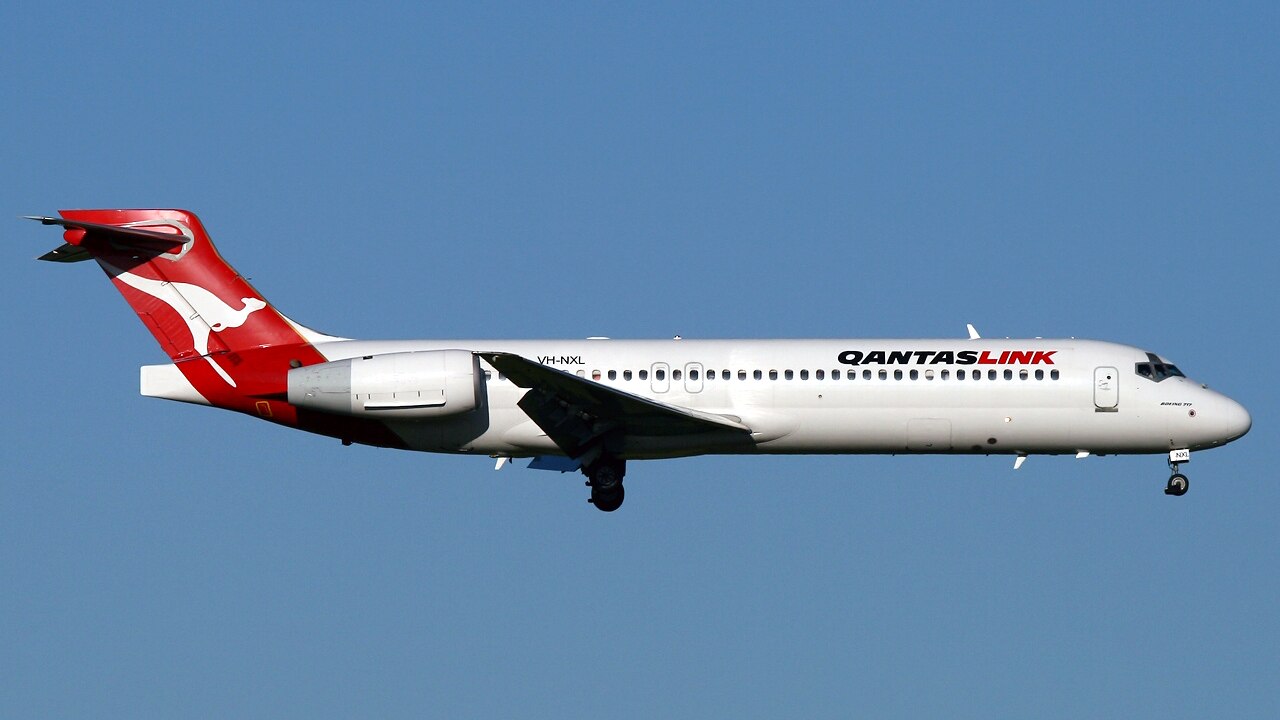
A QantasLink Boeing 717-200, like the one used in the Sydney to Hobart flight. (Supplied: Ian Lim/Wikimedia Commons)
QantasLink pilots experienced haziness, dizziness and slowed reactions while attempting to land at Hobart Airport last year, after noticing a chlorine odour coming from air-conditioning vents in the cockpit.
The captain reported hypoxia-like symptoms and had to hand over controls to the first officer, who then had difficulties lining up the plane with the runway.
It came just two days after cabin crew reported a chlorine odour and similar symptoms on board the same plane and it was diverted, but no fault could be found, so it remained in service.
The Australian Transport Safety Bureau (ATSB) has detailed the events on board a Boeing 717-200 travelling from Sydney to Hobart on the evening of June 4 – finding that the pilots chose not to use emergency oxygen supplies.
In a report released on Tuesday, the ATSB found that cabin crew noticed the chlorine smell while the plane was on its climb from Sydney.
The forward cabin crew reported dizziness, pressure in the head and a metallic taste, but when the smell disappeared and symptoms eased, a decision was made to continue to Hobart.
It was not until 1 hour and 20 minutes later – 10 nautical miles from Hobart – that the captain and first officer noticed the smell in the cockpit.
The captain experienced symptoms first – fogginess of thought, confusion, reduced situational awareness and tingling in arms and legs – and handed over controls to the first officer.
The first officer could no longer smell the chlorine, and decided that emergency oxygen was not required due to “the impending landing” and “perceived difficulties of donning the mask”.
The captain missed the usual 1,000-feet ‘stable’ call.
On the approach to the runway, the first officer then experienced symptoms.
“At about 100 feet above the runway elevation, the first officer experienced difficulties keeping the aircraft lined up with the runway centreline,” the ATSB report reads.
“The first officer reported that the aircraft was drifting to the right of the centreline, and that their reactions to correct the drift were slower than normal.”
They managed to land, with 54 passengers and five crew on board.
After landing, both pilots experienced persistent headaches, and a blood test several hours later found the captain had slightly elevated carbon dioxide levels, although these results were inconclusive.
Crew ‘unprepared’ for fume and incapacitation event
National Jet Systems – which operates the QantasLink flights – had reported 28 adverse cabin air quality events in the 12 months before the incident, 11 of which resulted in nausea-like symptoms.
None of these had impacted the safety of flights.
But the ATSB noted that National Jet Systems’ procedures did not consider the recurrence of fume events during the same flight, and if these led to an “incapacitation event”.
“As a result, the crew were unprepared for the subsequent fumes and incapacitation event, which occurred at a critical phase of flight, and did not use oxygen to significantly reduce the risk of both flight crew becoming partially incapacitated,” the report reads.
The crew also had “infrequently practised” putting on oxygen masks during their training, and the captain reported that they “tended to fog up” and make communication difficult.
ATSB chief commissioner Angus Mitchell said pilots should not hesitate to use emergency oxygen.
“This incident is a reminder to pilots to be alert to the potential hazard posed by odours and fumes, and to not hesitate to use supplemental oxygen,” he said.
Since the incident, National Jet Systems has carried out increased training in putting on masks, reviewed its smoke and fumes checklist, brought in new incapacitation procedures and reviewed its hypoxia training manuals.
The aircraft’s air-conditioning and pressurisation system was in automatic mode at the time, and does not recirculate air inside the aircraft.
News Related-
High court unanimously ruled indefinite detention was unlawful while backing preventive regime
-
Cheika set for contract extension as another Wallabies head coaching candidate slips by
-
Analysis-West's de-risking starts to bite China's prospects
-
'Beyond a joke' Labor won't ensure PTSD protections: MP
-
Formula One season driver ratings: Lando Norris shines as Max Verstappen nears perfection
-
Catalina golfer Tony Riches scores Guinness World Record four holes in one on same hole
-
Florida coach Billy Napier fires assistants Sean Spencer, Corey Raymond with expected staff shakeup ahead
-
Rohingyan refugee NZYQ accidentally named in documents published by high court
-
Colorado loses commitments of 2 more high school recruits
-
Queensland Health issues urgent patient safety alert over national bacteria outbreak
-
Townsville Community Pantry 'distressed' by fruit, vegetable waste at Aldi supermarket
-
What Is The Beaver Moon And What Does It Mean For You?
-
Labor senator Pat Dodson to resign from politics due to health issues
-
Hamas releases 11 more hostages, as Israel agrees to extend ceasefire
